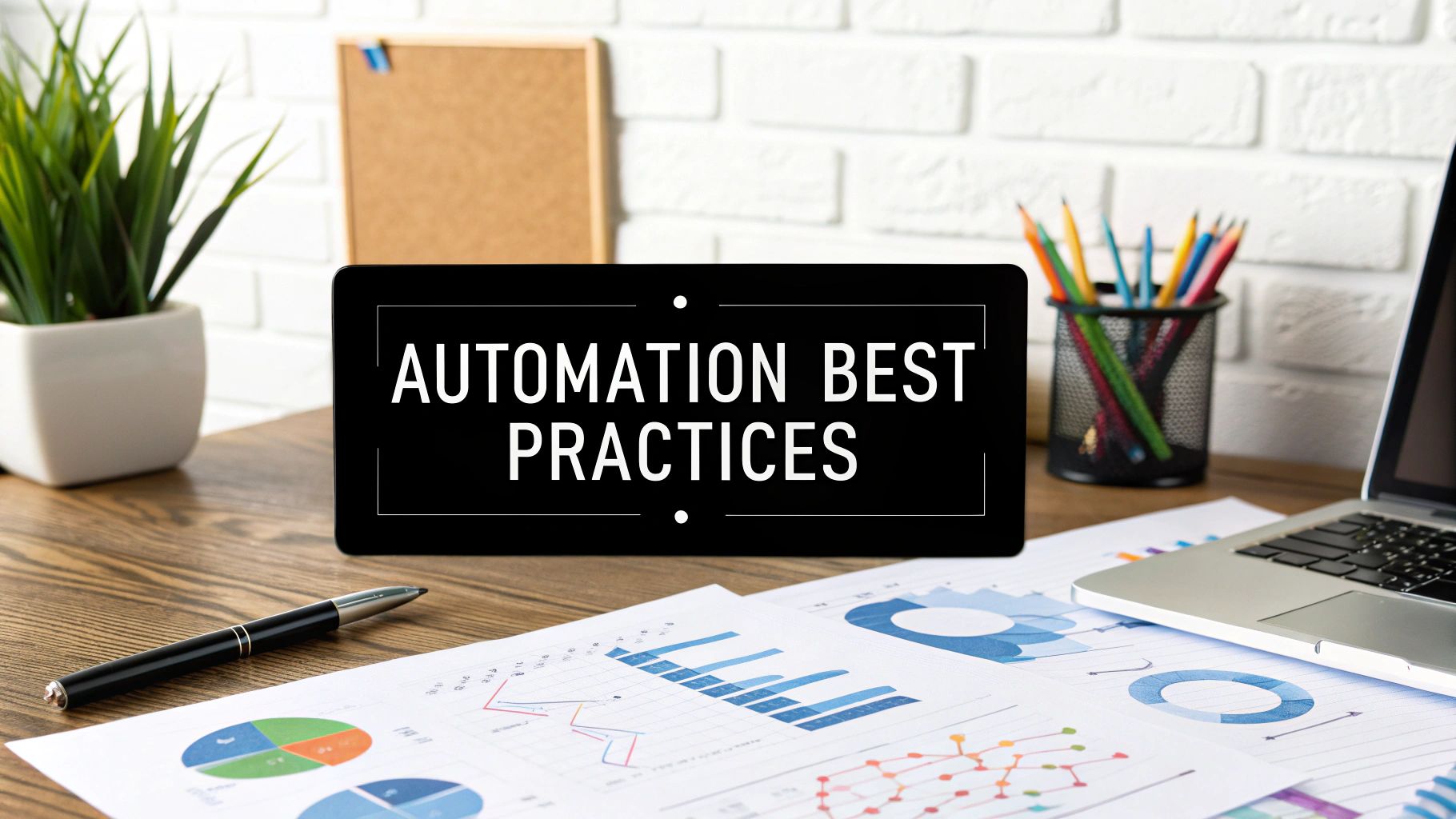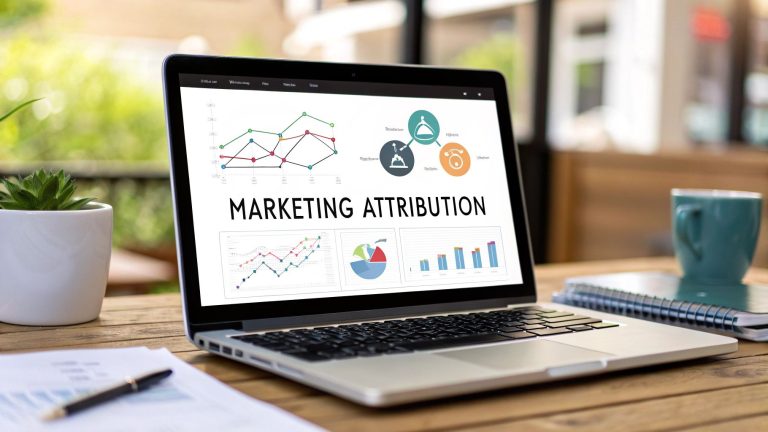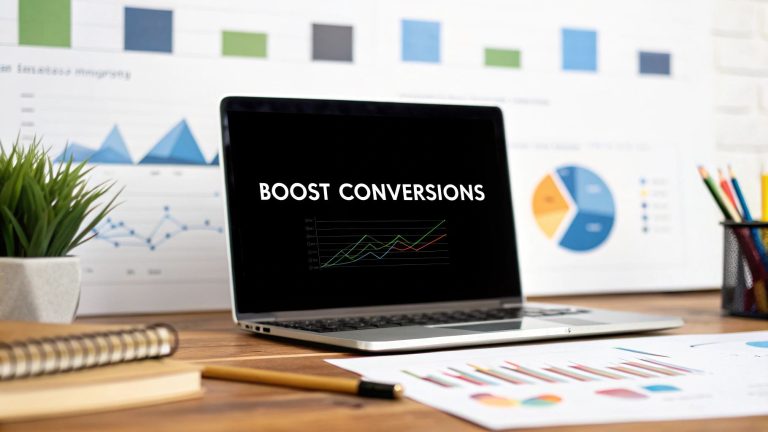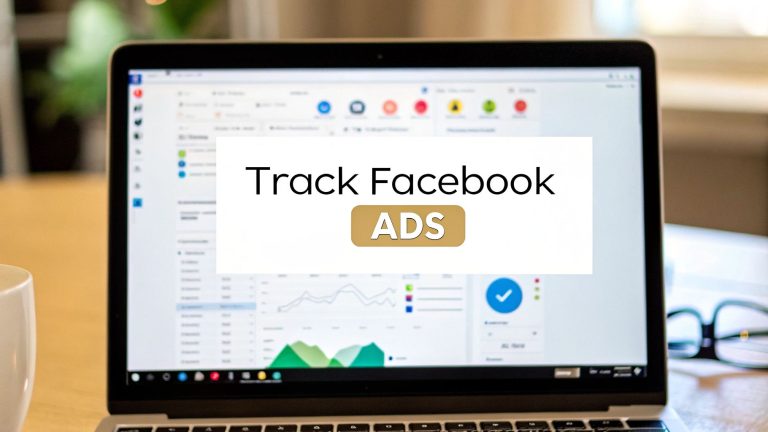8 Marketing Automation Best Practices for 2025
Marketing automation promises a world of efficiency, but simply flipping a switch isn't enough. Many businesses invest in powerful tools only to see lackluster results, struggling with generic campaigns and disjointed customer experiences. The gap between potential and reality is bridged by strategy. True success lies not in the software itself, but in implementing proven marketing automation best practices that transform your platform from a simple task manager into a sophisticated growth engine.
This guide moves beyond surface-level advice to provide a strategic blueprint. For a comprehensive look at building the foundational plan, this ultimate guide to marketing automation strategy offers an excellent starting point. Building on that, we will explore 8 critical practices, from intelligent audience segmentation and lead nurturing to data-driven ROI measurement, that empower you to build meaningful relationships and drive conversions.
For instance, while a tool like LeadSavvy Pro can instantly capture leads from your Facebook Ads, the automated journey that follows is what truly determines success. The goal is to make every automated interaction count. Let's dive into the actionable strategies that will help you not only save time but also create tangible, measurable business impact.
1. Audience Segmentation and Personalization
The foundation of any successful marketing automation strategy is the ability to treat your audience not as a monolith, but as a collection of individuals with unique needs and interests. This is where audience segmentation and personalization become critical. Segmentation involves dividing your contacts into smaller, distinct groups based on shared characteristics. These can range from simple demographics to complex behavioral patterns.
Personalization is the action you take based on that segmentation, delivering content and experiences tailored to each group's specific context. This approach moves beyond generic, one-size-fits-all messaging. Instead of sending the same email to every subscriber, you can send targeted offers to high-value customers, re-engagement campaigns to inactive users, or welcome sequences to new leads. This targeted communication is one of the most effective marketing automation best practices for building stronger customer relationships and driving conversions.
Actionable Strategies for Implementation
To effectively implement segmentation, start simple and expand as you gather more data.
- Start with Broad Categories: Begin with demographic data (age, location) and firmographic data for B2B (company size, industry). As you collect more information, you can layer on behavioral data like purchase history, website pages visited, or email engagement levels.
- Utilize Progressive Profiling: Instead of asking for every detail upfront, use forms that gradually build customer profiles over time. For example, a first-time download might only require an email, while a subsequent interaction could ask for company size or job title. This reduces initial friction and enriches your data incrementally.
- Implement Dynamic Content: Use dynamic content blocks within your emails or on your landing pages. This allows you to show different images, calls-to-action, or offers to different segments within a single campaign, scaling personalization efficiently.
The Impact of Segmentation on Engagement
The data clearly shows that audiences respond positively when they receive relevant, personalized content. The following infographic highlights the dramatic lift in key email marketing metrics achieved through targeted segmentation.
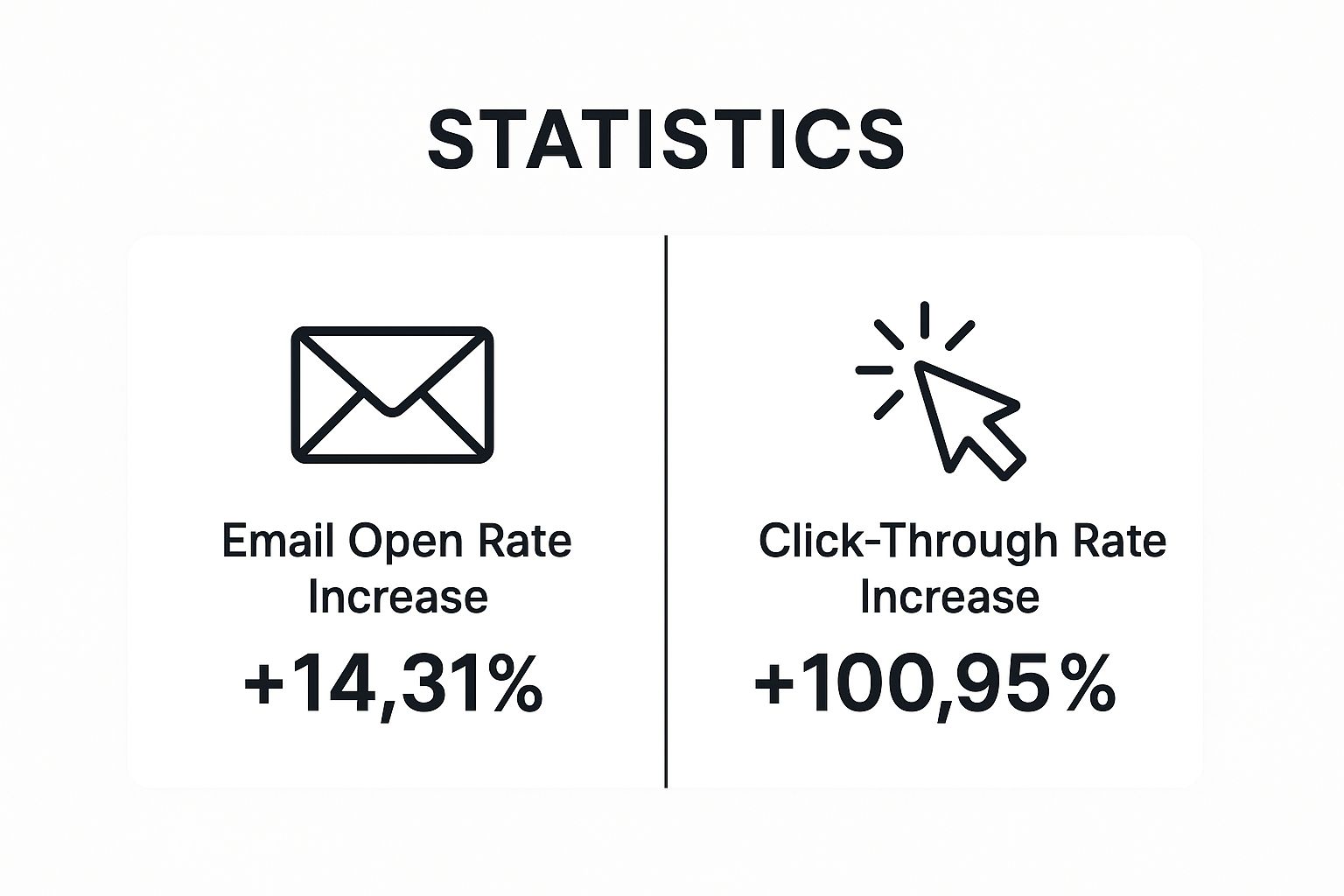
These statistics underscore a crucial point: segmentation not only gets more people to open your emails but also doubles the likelihood that they will take action on your message. This powerful combination directly translates to higher engagement and a better return on your marketing investment.
2. Lead Scoring and Nurturing
Not all leads are created equal. A critical marketing automation best practice is to systematically identify which prospects are ready for a sales conversation and which need more time. This is accomplished through lead scoring, a method of assigning points to leads based on their profile and engagement level. A high score indicates a "hot" lead, while a lower score suggests the lead is still in an early research phase and requires further nurturing.
Lead nurturing is the automated process of sending targeted, relevant content to these leads over time. Instead of pushing for a sale prematurely, nurturing campaigns build trust and guide prospects through the buyer's journey. By combining scoring with nurturing, you ensure that your sales team focuses its energy on the most qualified opportunities, while your automation platform cultivates future customers. This synergy is fundamental to an efficient marketing engine.
Actionable Strategies for Implementation
A successful lead scoring system is built on collaboration and continuous refinement.
- Define Your MQL Criteria: Work closely with your sales team to define the characteristics of a Marketing Qualified Lead (MQL). Agree on point values for explicit data like job title, company size, and industry, as well as implicit behavioral data like webinar attendance, pricing page visits, or demo requests.
- Implement Lead Decay: A lead's interest can wane over time. Implement lead decay to automatically subtract points from a lead's score if they become inactive for a specific period, such as 30 or 60 days. This keeps your pipeline fresh and ensures scores accurately reflect current interest levels.
- Develop Nurturing Tracks: Create distinct nurturing workflows for different segments and score thresholds. A low-scoring lead might receive top-of-funnel educational content, while a mid-scoring lead could get case studies and product comparisons. As leads move through your pipeline, seamlessly integrating sales funnel automation is crucial for boosting conversions and ensuring a smooth handoff to sales.
The Impact of Scoring on Sales Efficiency
Implementing a structured scoring and nurturing process directly impacts sales cycle length and conversion rates. For instance, Microsoft famously increased its conversion rates by 30% by refining its lead scoring system to better identify sales-ready leads. Similarly, Lenovo reduced its sales cycle by a significant 20% through automated nurturing that educated prospects before they ever spoke to a salesperson. These examples show how prioritizing leads empowers your sales team to close more deals, faster.
By focusing on the right leads at the right time, you bridge the gap between marketing efforts and sales results, creating a more cohesive and profitable revenue operation. For a deeper dive into building effective workflows, you can learn more about automated lead nurturing strategies on leadsavvy.pro.
3. Drip Campaigns and Automated Email Sequences
A cornerstone of effective marketing automation is the use of drip campaigns, which are pre-written series of emails sent automatically to contacts based on specific triggers or timelines. These sequences nurture relationships over time by delivering relevant, valuable content at optimal intervals. Instead of broadcasting a single message, they guide recipients through a predetermined journey, such as onboarding, lead nurturing, or post-purchase follow-up. This methodical approach is one of the most reliable marketing automation best practices for systematically moving leads through the sales funnel.
This practice is powerful because it automates the process of building trust and providing value. A well-designed sequence ensures no lead is forgotten and every customer receives timely communication that aligns with their stage in the customer lifecycle. For example, Dropbox uses an onboarding sequence to guide new users through key features, increasing product adoption, while Grammarly sends weekly writing insights to maintain user engagement and demonstrate ongoing value.
Actionable Strategies for Implementation
To build a high-performing drip campaign, you need to think strategically about the customer's journey.
- Map the Customer Journey: Before writing a single email, outline the key stages a user goes through, from initial awareness to becoming a loyal advocate. Design your email sequence to mirror and support this journey, providing the right information at each step.
- Use Behavioral Triggers: While time-based sequences are useful, behavior-triggered campaigns are more effective. Send emails based on actions like visiting a pricing page, abandoning a cart, or downloading a resource. This ensures your message is contextually relevant and timely.
- Keep Content Fresh and Focused: Each email in your sequence should have a single, clear purpose and call-to-action (CTA). Regularly review and update the content to ensure it remains accurate, relevant, and engaging. A stale or outdated sequence can do more harm than good.
The Power of Automated Nurturing
Automated email sequences are essential for scaling communication without sacrificing a personal touch. They work 24/7 to nurture leads, onboard customers, and re-engage dormant contacts, allowing your team to focus on more strategic initiatives. The following video explains how to conceptualize and build these powerful nurturing funnels.
By automating these crucial touchpoints, you create a consistent and reliable system for customer communication. This not only improves efficiency but also drives higher conversion rates by delivering the right message at the moment it’s most likely to resonate with the recipient.
4. Behavioral Trigger Automation
Moving beyond static campaign schedules, behavioral trigger automation allows you to engage with customers in real-time based on their specific actions. This practice involves setting up automated workflows that respond instantly when a user takes a predefined action, such as visiting a specific webpage, abandoning a shopping cart, or downloading a resource. It is one of the most powerful marketing automation best practices because it delivers highly relevant, contextual messages at the exact moment a user shows intent.
Instead of waiting for a scheduled newsletter, a customer who views a product page multiple times could receive a follow-up email with more details or a special offer. This immediacy makes the interaction feel personal and timely, significantly increasing the likelihood of conversion. For instance, a lead who interacts with pricing pages on your site can be automatically added to a "high-intent" segment within LeadSavvy Pro and receive a targeted message from a sales representative, capitalizing on their peak interest.

Actionable Strategies for Implementation
To harness the power of behavioral triggers, focus on high-impact actions first and expand your automation as you learn what resonates with your audience.
- Start with High-Value Triggers: Begin by automating responses to crucial actions like cart abandonment, browse abandonment (viewing a product but not adding to cart), or a first purchase. These are moments where a timely nudge can directly recover lost revenue or foster loyalty.
- Set Appropriate Frequency Caps: While timely communication is key, overwhelming users is a risk. Use your automation platform's settings to limit how many triggered messages a single user can receive in a specific timeframe. This prevents fatigue and keeps your communication welcome.
- Personalize Content with Behavioral Data: Use the trigger itself to inform the message content. For an abandoned cart email, dynamically insert the specific products left behind. For a browse abandonment trigger, reference the product category the user was exploring to provide helpful recommendations.
- Test and Optimize Trigger Timing: The effectiveness of a triggered message often depends on timing. Test different delays for your workflows. An abandoned cart reminder might work best sent one hour later, while a re-engagement email for an inactive user might be more effective after 30 days of no activity.
5. Multi-Channel Campaign Integration
Modern customers interact with brands across a multitude of touchpoints, from email and social media to SMS and in-app notifications. One of the most critical marketing automation best practices is to orchestrate these interactions into a single, cohesive experience. Multi-channel campaign integration involves coordinating your messaging and workflows across these different platforms to ensure consistency and reinforce your core message. This approach moves beyond siloed efforts where the left hand doesn't know what the right hand is doing.
Instead of a customer receiving disconnected messages, they experience a unified journey. For example, a user who abandons their cart might first receive an email reminder. If that email goes unopened, a push notification could follow a few hours later, and the next day, a retargeting ad might appear in their social media feed. This ensures your message is delivered through the channels your audience actually uses, maximizing its impact and creating a seamless brand experience.
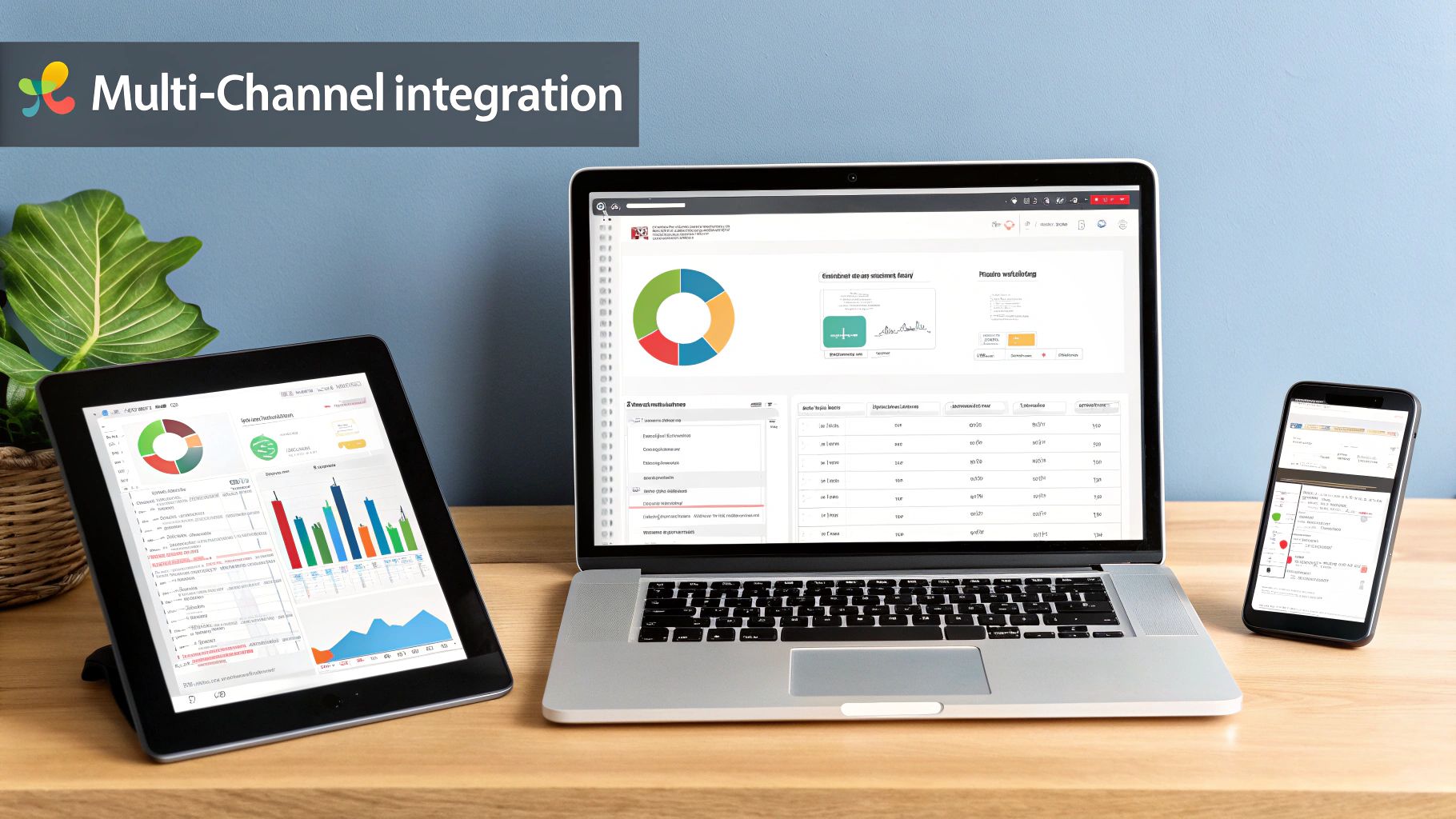
Actionable Strategies for Implementation
A successful multi-channel strategy requires careful planning and a solid data foundation. It’s not just about being present on every channel, but about using each one strategically.
- Build a Unified Customer View: Centralize your customer data into a single platform. LeadSavvy Pro acts as this hub, connecting interactions from your website, email campaigns, and social ads to create a comprehensive profile that informs your cross-channel workflows.
- Start with Two Channels: Don't try to boil the ocean. Begin by integrating two complementary channels, such as email and paid social ads. Once you have mastered the workflow and data flow between them, you can gradually expand to include SMS, push notifications, or other relevant platforms.
- Maintain Consistent Messaging: While the format of your content should be adapted for each channel (e.g., a concise SMS vs. a detailed email), the core message, offer, and brand voice must remain consistent. This prevents customer confusion and reinforces brand identity.
Why Integrated Campaigns Drive Better Results
The primary benefit of a multi-channel approach is meeting customers where they are. By leveraging the unique strengths of each platform, you create a more resilient and effective marketing engine. An integrated campaign, such as the one used by REI for its adventure-focused promotions, can span email newsletters, engaging Instagram stories, and targeted mobile app offers. This comprehensive strategy ensures that the message reaches a wider audience in the context they prefer, leading to significantly higher engagement and conversion rates than any single channel could achieve alone.
6. A/B Testing and Optimization
A core tenet of effective marketing is to never assume you know what works best. Instead, you should let your audience's behavior guide your strategy. This is the principle behind A/B testing, a systematic process of comparing two versions of a single variable, like an email subject line or a call-to-action, to determine which one performs better. By isolating one element and measuring its impact, you can make data-driven decisions that consistently improve campaign performance.
This iterative process is one of the most vital marketing automation best practices because it removes guesswork and bias from your strategy. Instead of relying on intuition, you use hard evidence to refine your messaging, timing, and design. From optimizing open rates with compelling subject lines to increasing conversions with clearer calls-to-action, A/B testing provides a clear path toward continuous improvement and a higher return on investment.
Actionable Strategies for Implementation
To make A/B testing a systematic part of your automation, build a structured process.
- Test One Variable at a Time: To get clear, reliable results, isolate a single element for each test. If you change both the subject line and the CTA button color in one email, you won't know which change was responsible for the performance difference. Start with high-impact elements like headlines, subject lines, and send times.
- Ensure Statistical Significance: Don’t declare a winner too early. Your marketing automation platform should tell you when a test has reached statistical significance, meaning the results are not due to random chance. This ensures you're making decisions based on reliable data.
- Document and Learn: Maintain a log of every test you run, including your hypothesis, the variants, the results, and your conclusion. This creates a valuable internal knowledge base that prevents you from repeating past mistakes and helps inform future campaign strategies. For example, in LeadSavvy Pro, you can use tags to label contacts based on which test variant they received, allowing for deeper analysis later.
7. CRM Integration and Data Synchronization
Your marketing automation platform and your Customer Relationship Management (CRM) system should not operate in separate silos. A core marketing automation best practice is to ensure these two powerhouses are deeply integrated, allowing for a seamless, bidirectional flow of information. This synchronization creates a single source of truth for all customer data, aligning sales and marketing efforts and eliminating costly data discrepancies.
When integrated, activities logged in your marketing platform, like email opens or content downloads, instantly enrich the lead profiles in your CRM. Conversely, updates made by the sales team in the CRM, such as a change in lead status or a new contact detail, can trigger automated marketing campaigns. This creates a cohesive customer journey where every interaction is informed by a complete, up-to-date understanding of the individual's history with your brand.
Actionable Strategies for Implementation
To build a reliable bridge between your marketing and sales systems, focus on a structured integration process.
- Map Data Fields Meticulously: Before you connect the systems, create a clear map of which fields in your marketing platform correspond to which fields in your CRM. Establish consistent naming conventions to prevent data conflicts and ensure information like "Job Title" maps correctly across both platforms.
- Define a Clear Lead Handoff Protocol: Establish automated rules that define exactly when a marketing-qualified lead (MQL) becomes a sales-accepted lead (SAL). This could be triggered by a lead score threshold, a specific action like a demo request, or a combination of factors. This ensures sales receives high-quality leads at the right time.
- Prioritize Data Hygiene: The quality of your synchronized data is paramount. To ensure your CRM integration and data synchronization are effective, it's crucial to implement proven strategies to improve data quality. Regularly audit for duplicates, incomplete records, and outdated information.
The Impact of a Unified System
The alignment of sales and marketing through CRM integration has a direct and measurable impact on revenue and efficiency. For B2B companies, the native integration between a CRM like Salesforce and a marketing platform like Pardot allows for sophisticated account-based marketing campaigns driven by real-time sales insights. This unified view empowers both teams to collaborate effectively on nurturing and closing deals. You can learn more about how CRM integration powers lead generation.
This synchronized environment doesn't just pass leads; it passes intelligence. When the sales team can see every marketing touchpoint and marketing can see the entire sales pipeline, both departments can make smarter, more strategic decisions that drive business growth.
8. Performance Analytics and ROI Measurement
Marketing automation is not a "set it and forget it" tool; it is a powerful engine that requires constant monitoring and optimization to deliver its full potential. This is where performance analytics and Return on Investment (ROI) measurement become indispensable. This practice involves systematically tracking, analyzing, and reporting on your marketing automation efforts to measure their direct impact on business goals. It's about moving beyond vanity metrics like open rates and focusing on what truly matters: revenue, customer lifetime value, and overall profitability.
Effective measurement requires setting up proper attribution models to understand which touchpoints contribute to conversions. By tracking key performance indicators (KPIs) tied to business objectives, you can gain a clear, data-backed view of what's working and what isn't. This analytical approach is one of the most critical marketing automation best practices because it transforms your strategy from guesswork into a data-driven science, enabling you to justify budgets and make smarter strategic decisions.
Actionable Strategies for Implementation
To build a robust analytics framework, you must be deliberate about what you track and how you track it.
- Define Clear KPIs: Before launching any campaign, establish specific, measurable KPIs that align directly with your overarching business goals. For a lead generation campaign, this could be cost per qualified lead. For an e-commerce promotion, it might be the conversion rate or average order value.
- Implement Comprehensive Tracking: Ensure all your digital assets are properly tagged. Use UTM parameters consistently across all campaigns to track traffic sources accurately in platforms like Google Analytics. This foundational step is crucial for attributing conversions correctly.
- Focus on Actionable Metrics: While metrics like social media likes are interesting, prioritize those that inform decisions. Focus on metrics such as customer acquisition cost (CAC), customer lifetime value (LTV), and conversion rates by channel. These provide a much clearer picture of your ROI.
The Impact of Measurement on Strategy
Regularly analyzing your performance data allows for continuous improvement and demonstrates the value of your marketing efforts to stakeholders. A well-defined measurement strategy is the difference between simply doing marketing and knowing your marketing is driving growth. It provides the insights needed to optimize campaigns, reallocate budget to high-performing channels, and refine your entire automation funnel for maximum efficiency.
This data-driven approach ensures every action is purposeful and contributes to the bottom line. To dive deeper into this topic, you can learn more about how to improve your marketing ROI on leadsavvy.pro. Ultimately, strong analytics are what empower you to prove, and improve, the value of your marketing automation investment.
Marketing Automation Best Practices Comparison
| Item | Implementation Complexity 🔄 | Resource Requirements ⚡ | Expected Outcomes 📊 | Ideal Use Cases 💡 | Key Advantages ⭐ |
|---|---|---|---|---|---|
| Audience Segmentation and Personalization | Medium-High; requires data collection and management | Moderate to High; data infrastructure and tools needed | Higher engagement, increased open & click rates, better ROI | Targeted campaigns needing personalized messaging | Highly relevant messaging, improved CLV |
| Lead Scoring and Nurturing | Medium; needs ongoing refinement and alignment | Moderate; scoring system and nurturing workflows | Improved sales efficiency, higher MQL to SQL conversion | Prioritizing leads, aligning sales & marketing | Focused sales efforts, better revenue attribution |
| Drip Campaigns and Automated Email Sequences | Low-Medium; upfront setup of sequences | Low to Moderate; content creation and automation | Consistent communication, scalable nurturing | Nurturing leads/customers over time | Saves manual effort, scalable relationship building |
| Behavioral Trigger Automation | High; sophisticated tracking and integration setup | High; advanced tracking and cross-channel integration | Timely, relevant messages; higher engagement and conversions | Real-time behavior response marketing | Contextual marketing, better re-engagement |
| Multi-Channel Campaign Integration | High; complex management and integration | High; resources for content + platform coordination | Cohesive customer experience, higher campaign ROI | Brands using multiple channels for integrated campaigns | Consistent branding and broader reach |
| A/B Testing and Optimization | Medium; requires design and statistical rigor | Moderate; testing tools and analysis resources | Data-driven optimization, better campaign performance | Campaign elements needing performance improvement | Reduces guesswork, continuous performance gains |
| CRM Integration and Data Synchronization | High; technical integration and maintenance | High; specialized IT and training resources | Improved sales-marketing alignment, higher lead quality | Synchronizing sales and marketing data and workflows | Unified customer data, better reporting |
| Performance Analytics and ROI Measurement | Medium-High; complex attribution and reporting setup | Moderate to High; analytics platforms and expertise | Clear insights, ROI measurement, data-driven decisions | Marketing impact measurement and budget allocation | Actionable insights, stakeholder transparency |
From Automation to Acceleration: Your Next Steps
Navigating the world of marketing automation can feel like learning a new language, but the principles we've explored are the foundational grammar for success. This isn't just about setting up a few automated emails; it’s about architecting a sophisticated system that listens to your audience and responds with value at every turn. Moving beyond basic automation requires a commitment to a cyclical process of strategy, execution, analysis, and refinement.
The journey from a novice user to an automation expert is marked by a shift in perspective. Instead of just asking "What can I automate?" you begin to ask "How can I create a more relevant, timely, and personalized experience?" This is where true growth happens. The marketing automation best practices we've covered, from deep audience segmentation and dynamic lead scoring to multi-channel integration and rigorous A/B testing, are your building blocks for creating this superior customer journey.
Unifying Your Strategy for Maximum Impact
The most powerful takeaway is that these practices are not isolated tactics; they are interconnected components of a single, unified strategy.
- Data is the Foundation: Your CRM integration and data hygiene practices directly fuel the accuracy of your personalization and segmentation. Poor data in means poor automation out.
- Behavior is the Trigger: Your behavioral triggers are only effective if your email sequences are compelling and your lead nurturing is aligned with the customer's stage in the funnel.
- Optimization is the Engine: Your A/B tests and performance analytics provide the crucial feedback loop needed to refine every other element, from your email copy to your lead scoring thresholds.
Mastering this interconnectedness is what separates campaigns that merely function from those that truly accelerate business growth. The ultimate goal is not just efficiency but effectiveness. It’s about building stronger, more profitable relationships at scale by proving to each lead that you understand their needs.
The Starting Point: Flawless Lead Capture
Of course, even the most sophisticated automation engine is useless without high-quality fuel. The entire process begins the moment a prospect shows interest, often through a Facebook lead ad. Delays or errors at this critical first step can render the rest of your well-crafted strategy ineffective. This is why securing a seamless, instant connection between your ads and your marketing systems is non-negotiable. By automating the foundational task of lead capture, you ensure your nurturing workflows are triggered instantly, capitalizing on peak prospect interest. This initial efficiency frees up your team to focus on the strategic application of these marketing automation best practices, turning raw leads into loyal, high-value customers.
Ready to eliminate the first bottleneck in your automation workflow? LeadSavvy Pro instantly and reliably syncs your Facebook Lead Ads directly to your email or CRM, ensuring no lead is ever lost or delayed. Start fueling your automation engine with the speed and accuracy it deserves by visiting LeadSavvy Pro to get started today.

